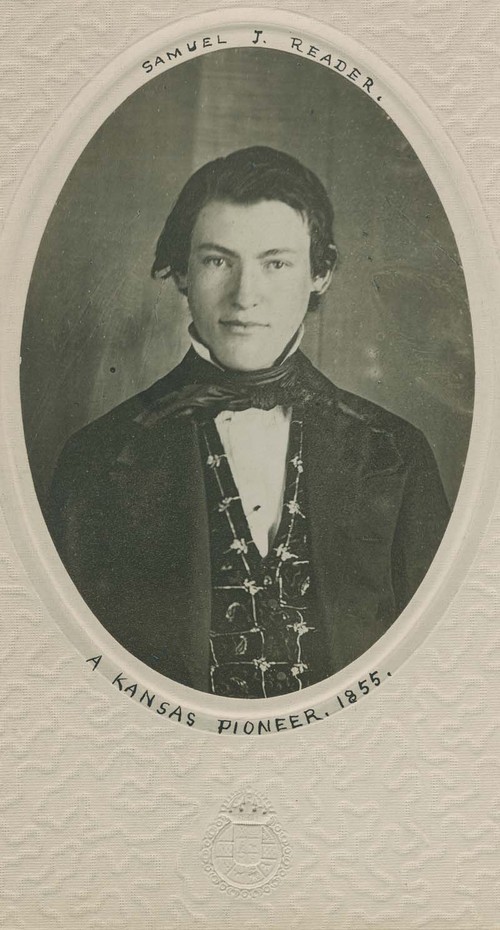Happy 188th Birthday American Diarist Samuel J. Reader

Samuel J. Reader was a Kansas pioneer who was one of the first to settle in the now extinct town of Indianola, KS in 1855. He was born in Greenfield, now Coal Center, Pennsylvania on January 25, 1836, to Francis and Catherine Reader. He was the youngest of two children, his older sister Eliza was born in December 1833. Unfortunately, his mother died when he was just four months old. He and his sister went to live with their Aunt Eliza James who was their mother’s sister. In 1839 he and his sister moved with their aunt to Wellsburg, Virginia. Two years later in 1841 their father gave his permission for Eliza to take the children west. Samuel, his sister, his aunt Eliza, his uncle Samuel, and his grandfather William moved to La Harpe Illinois. It was while he was living in La Harpe that he began to keep a daily journal when he was 13 years old. He was inspired by the journals of Lewis and Clark. Like them he included sketches and maps in his diaries. He quit school at 16 or 17 but taught himself the Pitman Shorthand Method. He would also write sections in French. After his aunt married Joseph M. Cole the family moved to Hills Grove, Illinois in 1854. It was here that he worked in a stone quarry and managed to save up $164 in gold or about $6,183 today. He used this money to buy a lot of land in Indianola, KS and 160 acres of farmland in what was then Calhoun County (now part of Shawnee County). At just 19 years old he was one of the youngest large landowners in the territory.
Samuel moved to Kansas during a time known as Bleeding Kansas when a bitter border war was raging between those who were proslavery and those who were antislavery. Samuel took an anti-slavery position which he documented in his diaries. He wrote in a young, romantic style about his eagerness to fight for a free Kansas. When Lawrence was raided on August 28, 1856, by proslavery rebels he was kept from joining with 125 others who were going to rescue Lawrence. The next day shots rang out from the direction of Indianola and residents assumed that it was proslavery sympathizers attacking the town. Samuel set out to fight following the examples of the Indianola Free State Guards. The “Battle of Indianola” ended with no shots being fired after Samuel handed his Uncle Cole’s sword to a proslavery neighbor. Ten days later Indianola was raided. Samuel participated in the Battle of Hickory Point just days after Indianola was attacked. His involvement in the border conflicts and eyewitness accounts give his diaries added importance. Samuel joined the border war when General James Lane sent word that reinforcements were needed for the regiment.
After the Civil War broke out Samuel mustered into Company D, 2nd Kansas Infantry Regiment, Kansas State Militia as quartermaster and he reported for duty on September 1, 1863. He fought at the Battle of the Big Blue, also known as the Battle of Byram’s Ford on October 22, 1864. Located in Jackson County Missouri, this battle was Samuel’s only war experience. It was during this two day battle that Samuel and many other Union soldiers were captured by the Confederates. He and his fellow prisoners were then marched south into Kansas. However, Samuel made his escape on October 25, 1864, just hours after the Battle of Mine Creek, the only Civil War battle fought in the state of Kansas. Samuel escaped disguised as a Confederate soldier and walked all the way home to Indianola. It took him four days to complete the journey. He wrote a detailed account of this in the third volume of his autobiography.
Samuel began to write to Elizabeth Smith of La Harpe, Illinois in 1866. They were married on December 17, 1867, Samuel was 31 and Elizabeth was ten years his junior. They had three children: Ruth—born September 25, 1868, Elizabeth “Bessie”—born October 10, 1871, and Frederick Augustine—born January 19, 1873. Frederick sadly passed at just over six months old, possibly from pneumonia. Their eldest, Ruth, died when she was sixteen from Rheumatic Fever. After Ruth passed their only surviving child, Bessie, became very dear to them. Unfortunately, Samuel would also lose his wife after 20 years of marriage when she died from a spinal disease that caused her to be bedridden for twenty months before she died in March 1898. Samuel suffered from Rheumatism at the end of his life and by 1903 he was addicted to both Morphine and its derivative Codeine which were both prescribed by his doctor. During a massive flood in 1903 he was bedridden in North Topka (now part of Topeka) and had to be rescued from his second story window by boat. Samuel continued his daily diary entries until July 1913 when he finally ceased writing. He was an active member of the Grand Army of the Republic (G.A.R.) Blue Post No. 250 and in 1901 he was elected commander of the post. His daughter, Bessie, would remain by her father’s side as a constant and loyal companion until his death on September 15, 1914, at 78 years old. He died just four months after the dedication of Memorial Hall in downtown Topeka to Union Veterans. He and his family aside from Bessie are buried in Rochester Cemetery in Topeka. His obituary ends saying: He belonged to no church, subscribed to no creed and was independent in politics as well as church matters.
Samuel’s legacy lives on in his diaries of which there are many. He kept a total of fifteen during his lifetime. However, only thirteen survive as volumes one and four were lost in a fire that destroyed his Indianola home in 1890. Large portions of his diaries and illustrations are now accessible online at Kansas Memory. His legacy also lives on through photography which he had a fondness for. Several of his photographs were donated to the Kansas Historical Society and are now included in the Photograph Division’s Collection of images of Shawnee County and Topeka. The Kansas Historical Society’s Museum Department is home to at least four of his paintings. He was known to draw and paint family members, and local scenes throughout his life. He also drew a number of battle scenes which fill his diaries. His illustrations are now often used in books and articles on the Civil War in the west. As for the town he called home, Indianola, it suffered greatly after the Kansas Pacific Railway built its railroad line through Topeka in 1865. The residents began to move away, and the Post Office closed on December 29, 1868, making the town now extinct. Samuel’s sketches and writings are used to tell the story of the Battle of Mine Creek at the Mine Creek visitor center just north of Pittsburg, KS. Samuel left an indelible mark on the history of Kansas and an incredible record of life during a time of great turmoil in both state and national history. Thanks to his writings we have a tangible link to the past that has lasted for generations.
Thanks for reading. Be sure to share and subscribe. You can also help support independent journalism in Kansas by buying me a coffee at buymeacoffee.com/kscon.

Emily Brannan
Emily Brannan is a born and raised Kansan. Graduating from Missouri Southern State University in Joplin, MO with a Bachelor of Arts in History with a minor in American Studies, she is now a historian, writer, and researcher.
